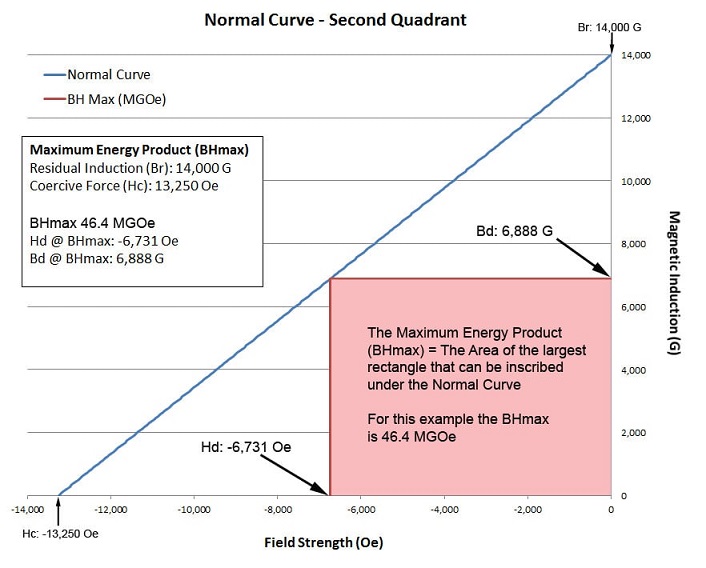What is Maximum Energy Product (BH)max?
There are four main indicators for measuring the performance of permanent magnets: remanence, coercivity, intrinsic coercivity, and maximum energy product (BH)max. In the following posts, we will introduce these concepts and their applications one by one. In today's article, let's take a look at the maximum energy product (BH)max first.
 What is the Maximum Energy Product (BH)max?
What is the Maximum Energy Product (BH)max?
The maximum energy product (BH)max represents the magnetic energy density established in the space between the two magnetic poles of the magnet, that is, the static magnetic energy per unit volume of the air gap. It is the maximum product of the residual magnetism Br and the intrinsic coercivity Hcj (unit kJ/ m3 or GOe), and its size directly indicates the performance of the magnet.
Magnetic Energy Product Curve
The product BH of the magnetic induction intensity B and the magnetic field intensity H at any point on the demagnetization curve of the permanent magnet is called the magnetic energy product. Its size is proportional to the magnetic energy density of the magnet in a given working state. The relationship curve between the magnetic energy product and the magnetic induction intensity B is called the magnetic energy product curve. It is a curve obtained by multiplying the value of each point B and H on the permanent magnet demagnetization curve as the abscissa, and the magnetic induction intensity B as the ordinate. The magnetic energy product reaches the maximum at a certain position in the middle of the demagnetization curve, which is called the maximum magnetic energy product (BH) max. For permanent magnet materials whose demagnetization curve is a straight line, the magnetic energy product is the largest at (Br/2, Hc/2).
The Relationship between Maximum Energy Product & Magnet Performance
For two magnets with the same size, the same number of poles, and the same magnetizing voltage, the magnet with a high magnetic energy product can obtain high surface magnetism. At the same (BH)max value, the levels of Br and Hcj have the following effects on magnetization: 1. Br is high and Hcj is low: under the same magnetizing voltage, higher surface magnetism can be obtained. 2. Br is low and Hcj is high: to obtain the same surface magnetism, a higher magnetizing voltage is required.
The Maximum Energy Product (BH)max & the Grades of Magnets
The numbers in the grades of NdFeB magnets represent the maximum energy product (BH)max of the product. For example, 38 and 45 in N38 and N45SH represent the maximum energy product of the product as 38MGOe and 45MGOe. The larger the number, the greater the maximum energy product (the letter after the number represents the classification of its intrinsic coercivity, the more backward of the letter indicates the greater the intrinsic coercivity). The grades of SmCo magnets, such as SmCo16, SmCo18, SmCo24, SmCo26, SmCo28, etc., the numbers also represent the typical value of the maximum magnetic energy product of the product.
Conclusion
Thank you for reading our article and we hope it can help you to have a better understanding of the maximum energy product (BH)max. If you want to know more about magnets, we would like to advise you to visit Stanford Magents for more information. Stanford Magnets is a leading magnet supplier across the world, that has been involved in R&D, manufacturing, and sales of permanent magnets and non-permanent magnets since the 1990s. It provides customers with high-quality ceramic magnets, Samarium Cobalt magnets, AlNiCo magnets, and neodymium magnets at a very competitive price.















